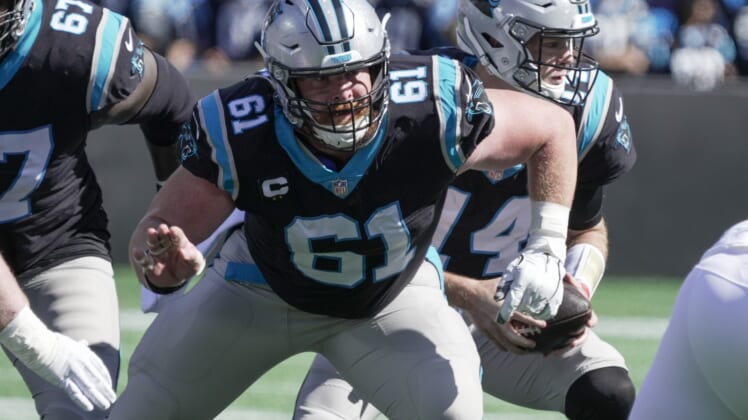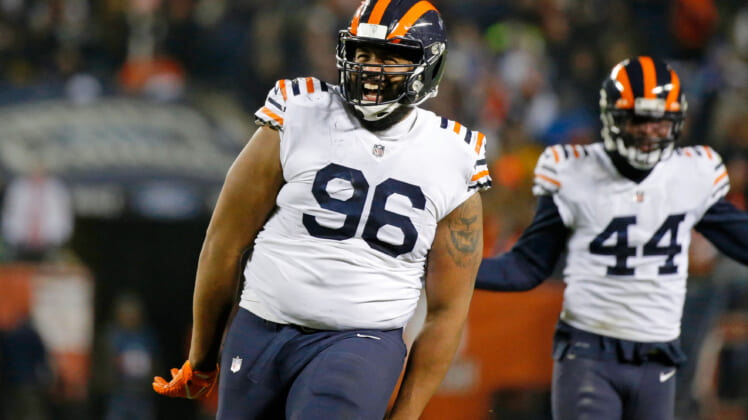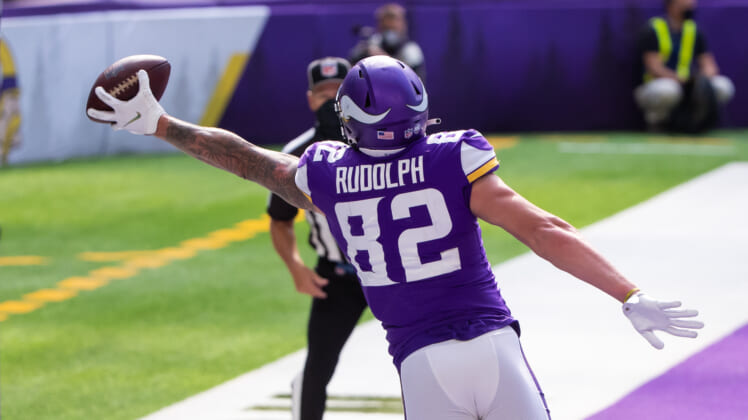Now that the 2022 NFL Draft is complete, teams are doing what they can to address any remaining needs they may have. This includes the Minnesota Vikings.
Maybe a player they had their eye on in the player selection process went off the board just before their turn on the clock, which could still leave the organization feeling less than stellar about some of the positions on their depth chart.
Here are three more moves the Minnesota Vikings should make before the season kicks off in September.
Strengthen the trenches to support Kirk Cousins

I get it, Vikings fans want JC Tretter to play the pivot. We do too, Tretter’s potential signing was covered here and another dream scenario here, so we’re picking an alternative upgrade over Garrett Bradbury for this piece. In this case, Matt Paradis serves as a more affordable veteran option if Tretter’s knee worries or asking price is a concern within the front office.
Paradis, 32, has started 98 games at center in his seven-year NFL career. He won a Super Bowl with the Broncos during his rookie season, starting all 19 games in 2015. Unfortunately, Paradis tore his ACL in November and that could be the cause for a slow-developing market for his services. He may not be ready for the start of the year, but the team still has Bradbury and Austin Schlottmann who can do just fine should Paradis have to miss some time.
He has the potential to be an upgrade over Bradbury based on his previous success before signing with the Panthers. Ever since he signed with Carolina, a team that has struggled to pass the ball, Paradis has seen his pass blocking grades go in the tank according to Pro Football Focus.
Matt Paradis pass blocking grades:
- 71.5 in 2015 as a rookie
- 82.7 in 2016
- 80.1 in 2017
- 78.6 in 2018
- 43.8 in 2019, first year with Carolina (Kyle Allen started 13 games at QB)
- 65.4 in 2020
- 53.6 in 2021
Are the Panthers inefficient as an offense because of Paradis, or are their quarterbacks holding him back? This is what scouts in the front office have already likely looked at, which could be why he has yet to sign elsewhere. But even the 53.6 grade tops Bradbury’s career-high grade of 43.7, which came last season.
No hope for Bradbury?
Of course there’s still some potential upside with Bradbury, especially now that he has a new coach, coordinator and offensive scheme. Some, not all, young offensive linemen tend to take a few years before they find their footing at the next level. Brian Allen, who was a center with the Rams during Kevin O’Connell’s tenure was one player who improved greatly playing in a new scheme. Bradbury could very well be one of these cases.
A strong run blocker, Bradbury just needs to find a way to hold up better at the point of attack against stronger nose tackles. Thus far, he has proven incapable, ranking 38th in pass protection grades among centers per Pro Football Focus. But he’s also suffered a myriad of injuries and strange shortened/limited offseasons. Maybe this can be the year he puts it all together?
In the end, the Vikings shouldn’t hesitate to at least bring in more competition for his starting role, if not replace him altogether. For what it’s worth, coach KOC offered Bradbury praise in his opening press conference, which at least provides some hope.
Related: Minnesota Vikings: Centering around Garrett Bradbury
Add Akiem Hicks to front seven

Kwesi Adofo-Mensah has done a fine job of adding pieces to this defense that should help turn the unit around in 2022. Along the defensive line, there’s a healthy amount of depth, but the issue is they’ll be relying on unproven players. As it stands right now, they figure to start Harrison Phillips at the nose, and Dalvin Tomlinson at another spot on the line, but who’s the other starter?
One could make a case for Armon Watts or James Lynch, who have flashed talent in limited spurts, but is the new regime, a group led by defensive coordinator Ed Donatell, really convinced in their abilities? After largely ignoring the position through the draft, it’s possible the organization is still looking to improve in the trenches.
A familiar face for Donatell is Akiem Hicks, who has wrecked Minnesota gameplans for the past six seasons with the Chicago Bears. In that time, Hicks worked with Donatell from 2015-18, when Hicks made his lone Pro Bowl team. Sure, Donatell coached the defensive backs, but he’s quite familiar with what Hicks offers.
The 32-year-old defender has missed 20 games over the past three seasons, but when healthy, Hicks can still eff the play up on a consistent basis. Despite missing time, Hicks has posted 3.5 sacks in each of the past two seasons and tallied 29 pressures in 2020, showing he’s still a disruptive force.
Even his injury concerns could be alleviated by going to a defensive line rotation that allows Hicks to get more rest on a game-by-game basis. Even if the Vikings like the youth they have in the D-line room, Hicks can act as an on-field mentor to help bring the inexperienced lineman up to speed.
Related: Grading the Minnesota Vikings’ 2022 NFL Draft
Bring back Rudolph the Red Zone Reindeer

There’s no reason for a Kyle Rudolph reunion not to happen in Minnesota. The Vikings lost Tyler Conklin in free agency and have yet to truly replace him. They signed Johnny Mundt, who’s familiar with coach Kevin O’Connell’s system and that’s likely going to be his only role, to help others learn the new system, while competing for the third tight end role on the roster. This is a player with just 10 career catches across five seasons, he’s not going to have a prominent role, if he even makes the roster.
In the draft they added Nick Muse in the seventh round, who may or may not make the roster either.
They do still have Zach Davidson, an extremely raw player the last regime drafted in the fifth round a year ago, but there’s no guarantee he can suddenly snag a roster spot either. There’s also Hawley, Minnesota native Ben Ellefson, who’s the current in-house favorite to be the blocking tight end on the roster. For the most part, the Vikes are unproven behind Irv Smith Jr. and he’s not even a sure thing.
This means the Vikings still have a pressing need for a capable TE2, a role that suits Rudolph perfectly at this stage of his career. Never overly athletic, his biggest strength has always been his hands, his size, and his ability to box out defenders, placing himself in the best position to come down with the football using his 6-foot-6 frame. The Vikings don’t need him to reinvent the wheel, he just needs to block when asked and catch whatever targets come his way, which Rudolph can still do in his sleep. It’s a no-brainer.
Related: One weird trick to get a top-5 offense for the Minnesota Vikings